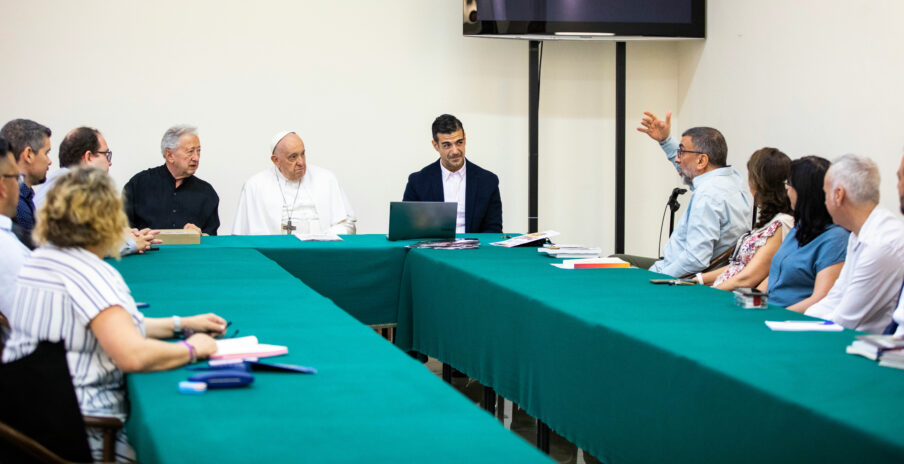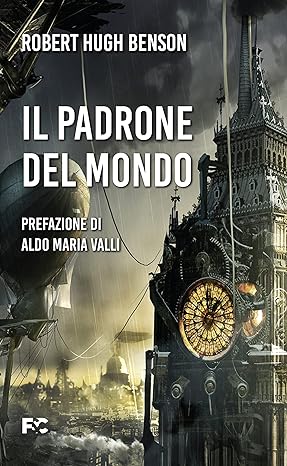
Interview / Archbishop Carlo Maria Viganò with Aldo Maria Valli After Bergoglio’s Statements to the Spanish Newspaper “Vida Nueva”
AMV: Your Excellency, we often say “motus in fine velocior” – “movement is faster towards the end” – about Francis’ attitude aimed at liquefying what little remains of Catholic doctrine and espousing the thought of the world. The most recent news confirms this, including yet another one of his interviews. What is your assessment?
Carlo Maria Viganò: World Youth Day, celebrated this year in Lisbon, Portugal, has confirmed the acceleration of Bergoglio’s plan to provoke a schism: his latest appointments, which are provocative to say the least; the statements of the newly-appointed Cardinals, all of which confirm the “Bergoglian revolution”; the presence of James Martin to propagandize the acceptance of LGBTQ ideology by young people; Bergoglio’s recent statement to a transgender person: “God loves us as we are; go ahead” (here). The only thing missing was an interview in which the Argentine “confessed” to an editorial staff of genuflecting and cheering journalists to complete the picture (here).
The adoring tone of the interview is beyond embarrassing: which, for someone who claims to detest hypocrisy and servility, would sound tragic if it were not so grotesque. The cloying obsequiousness of the journalists went so far as to say that Bergoglio is “like a country priest accustomed to treating everyone equally, or a woman who from dawn to dusk goes out of her way to support her family.” The abject lyricism of Vida Nueva, however, has the drawback of exposing the false spontaneity of the interviewee’s words, which were in fact carefully dropped like time bombs waiting to see them detonate.
From the interview it appears that Bergoglio expected everything but to become pope. But the story says something very different…
I am amazed by Bergoglio’s literary gifts: the evocative re-enactment of how surprised he felt at the election does not reconcile with what we now know happened at the 2013 Conclave, which has also been confided by a Cardinal-elector who is unable to reveal it publicly. And in presenting himself as a speculum totius humilitatis – a mirror of all humility – he speaks of himself as a “victim of the Holy Spirit and Providence,” as if to attribute the misfortune of this “pontificate” to God Himself, and not to the maneuvers of both the deep church through the Mafia of St. Gallen and the deep state through the emails of John Podesta and Hillary Clinton.
So, let’s get to the time bombs…
The first time bomb: “The Synod was the dream of Paul VI. When the Second Vatican Council ended, he realized that the Church in the West had lost the synodal dimension.” These words are a way to confirm the subversive character of the “collegiality” of Vatican II, as a counterweight against the Petrine Primacy solemnly and infallibly proclaimed at Vatican Council I by Blessed Pius IX. Thus we learn that the episcopal collegiality theorized by the innovators in Lumen Gentium had to make use of the Synod of Bishops precisely as a parliamentary body on the model of civil forms of government. In essence, “collegiality” was the application in the ecclesiastical sphere of the Masonic principle spread by the French Revolution to overthrow the Catholic monarchies. “It is a question of moving forward to recover that synodal dimension that the Eastern Church has and we have lost,” Bergoglio said. But this “synodal dimension” is a modernist Newspeak term for not admitting their actual intent to deliberately subvert the Papacy as a monarchical form of authority. This is an attack on the divine institution of the Church, perpetrated by the one who should instead be defending her from heretics. We are witnessing the demolition of the supreme magisterial and governmental authority of the Roman Pontiff, which is the bond of Catholic unity, by the one who sits on the Throne of Peter and who acts and is obeyed by virtue of the authority recognized to the Roman Pontiff. It is like watching the fire chief giving orders to his subordinates to pour gasoline into the bush and set it on fire, after emptying the tanks and draining the water supplies.
There is also talk of the Synod of 2001…
Yes, in the worrying sequence of Bergoglian “reworkings of reality” there also appears a recollection of the Synod of 2001, when Bergoglio evokes this episode: “Then the cardinal in charge of coordination came, examined the papers, and began to say: ‘This is not voted on … nor this.’ I replied: ‘Your Eminence, this has come out of the groups…’” And the naïve listener thinks: “See how good Bergoglio is; he wants the basis for telling the Bishops what the real problems of the faithful are, etc. etc.,” only to discover that what had then “come out of the groups” was presented as such, no more and no less than what happened farcically at the 2015 “Synod on the Family,” for which the documents were prepared ahead of time by Bergoglio’s circle and had been previously approved by him; and now even more evidently with the “Synod on Synodality,” for which the questionnaire sent to the Dioceses, parishes and groups was formulated in such a way as to exclude certain questions and steer the answers in the desired direction. When Bergoglio reassures us, “But things have been ‘purified’; we have made progress, and today everything is voted on and listened to,” we must understand that the obstacles previously represented by the Congregation for the Doctrine of the Faith by other Congregations have now been eliminated either through the appointment of perfectly-aligned heretics or through the ouster of the Roman Curia from any coordinating role in deference to the “national churches” or the Episcopal Conferences, all of which are occupied by heretics and corrupt individuals who are subservient to Santa Marta.
“We also have the example of the Synod on the Family. From the outside, Communion for the divorced has been imposed on us as a great theme. In this case it was the psychology of the wave, which was trying to expand. But, fortunately, the result went much further… much further.” So much further, I would say, as to arouse the formal protest of some Cardinals and numerous prelates, priests, religious, and theologians, in the face of distancing from traditional doctrine in matters of adultery, public concubinage, and the family. Let us not forget the fraudulent operation with which some of Bergoglio’s minions stole from the mailboxes of the Synod Fathers the book about the errors of Amoris Lætitia which denounced the interference by progressives in the conduct of the Synod.
Even in areas where the dissent of the faithful and pastors against the current Vatican regime is greater, such as Africa, key roles of authority have been entrusted to people who enjoy Bergoglio’s support, even if they are completely inadequate to hold certain positions of great responsibility.
It therefore seems that the affirmation, “In the Synod the protagonist is the Holy Spirit,” serves to clothe with an aura of authority the decisions taken by Jorge Mario, which have absolutely nothing divine about them, and indeed reveal themselves as intrinsically opposed to the Catholic Magisterium.
There is also talk of “Vatican III”…
Yes, a journalist from Vida Nueva provocatively asks: “This Synod on synodality seems to cover everything: from proposals for liturgical renewal to the need for more evangelizing communities, passing through a true preferential option for the poor, a true commitment in terms of integral ecology, and the acceptance of LGBTQ collectives. Has it ever been thought of giving it the form of the Third Vatican Council?” It ought to horrify us even to hear the hypothesis that a Synod could address such very delicate issues – liturgical reform and the evangelization of communities – and others completely foreign to the purposes of the Church, such as “a true preferential option for the poor, a true commitment in terms of integral ecology, and the acceptance of LGBTQ collectives.” Yet these are the themes being addressed at WYD 2023 during these days, with the criminal indoctrination of thousands of young people on the theme of the “ecological emergency” and woke ideology. And they are the themes – repeated obsessively by the media, in schools, in the workplace, and in politics – of the Agenda 2030 and the Great Reset, both of which are ontologically incompatible with the Catholic religion because they are intrinsically antichristic and anti-Christian.
Bergoglio’s response is disturbing: “Things are not ripe for a Third Vatican Council. And it is not even necessary at this time, since Vatican II has not yet begun to be realized. This was very risky and had to be taken into account. But there is always that fear that spreads among us at the hands of the “old Catholics,” who already at Vatican I called themselves “depositories of the true faith.”
What is the ultimate goal?
We have come to understand that Bergoglio’s main purpose is to sow division and destroy. His modus operandi is always the same. First of all, he artificially provokes a “debate” on issues that cannot be the object of controversy in the Church, since they already been defined by the Magisterium: he pits the “ultra-progressives” against the “conservatives.” Traditional Catholics, as I explained earlier, have not followed these delusions of the neo-church for a long time, and that is good. Then he makes sure that what he wants to achieve – a doctrinal, moral, disciplinary, and liturgical change – is proposed by a mediator who appears to be neutral, who presents himself as trying to find a compromise, while in reality he panders to the progressive side. At this point Bergoglio, from on high and as if discovering only then that there is a question to be clarified on which an authoritative pronouncement is needed, imposes a change that seems less serious than what the ultra-progressives had requested, but which remains inadmissible for those who are Catholic, who at that point are forced to disobey. And this disobedience is instantly denounced as heresy or schism, simply by recalling the errors of the Old Catholics, who rejected Vatican I.
But here lies the most treacherous deception: the doctrinal deviations of the Old Catholics are simplistically dismissed by Bergoglio as having claimed to be “depositories of the true faith” – something that every heresiarch has always claimed to be doing – while the Old Catholics have shown that they share many more heresies with the Bergoglian Church than whatever they may have in common with traditionalists, beginning with the female priesthood. And it is surprising that Bergoglio does not remember that the doctrinal instances of the Old Catholics began well before the First Vatican Council, with questions regarding papal appointments of bishops in the Netherlands, but they soon showed their closeness with the modernists both by adhering to the Protestant ecumenical movement – which was firmly condemned by the Catholic Church – and by theorizing a return to the “faith of the undivided Church of the first millennium,” a theme that is so dear to the supporters of Vatican II.
We have therefore understood that the identification of an enemy – in this case “the rigid,” meaning Catholics who are faithful to the immutable Magisterium – is the corollary of the deification of the Revolution in the Church. The Synod is presented as the work of the Holy Spirit and Bergoglio is simply a victim of Providence. So, either we accept apostasy as being willed by God – which is absurd, as well as blasphemous – or we end up ipso facto in the circle of Bergoglio’s enemies, deserving for this very reason the condemnation reserved for heretics and schismatics. It is a strange way of understanding the parrhesia [frankness] and inclusiveness of the church of mercy.
The interview also takes up the theme of the “rigid,” who are so disliked by the pope…
“Francis is in no way oblivious to the resistance to reform that he is about to carry out,” a journalist comments. And he cites the words of a priest “who has one foot in the Curia and the other in his diocese” – “I am concerned about the rigidity of young priests,” Bergoglio concludes. Of course!
It reassures the readers, amazed that Bergoglio has not yet ventured into one of his monologues against priests who I will not call traditional, but who are even vaguely conservative. From the very first days of his “pontificate” it is precisely against those “rigid priests” that he has woven an unmatchable series of insults and scorn. The provocation of the priest “who smells of the smell of sheep” – I imagine also wearing jeans and tennis shoes – offers an opportunity to this actor, who does not fail to capitalize on it, promptly replying:
“They react this way because they are afraid of a moment of insecurity that we are experiencing, and that fear prevents them from moving forward. We need to remove this fear and help them.” This is a psychoanalytic approach that leaves us astonished, in truth, and that betrays the desire to reprogram the clergy, who are rightly worried about a “moment of insecurity” that has been going on for the past sixty years so as to induce them to give in to the innovations and deviations of the Council. But the words of pharisaic understanding immediately turn into accusations and insinuations: “On the other hand, that shell hides a lot of rottenness. I have already had to intervene in some dioceses of various countries with similar parameters. Behind this traditionalism we have discovered serious moral problems and vices, double lives. We all know of bishops who, needing priests, resorted to people who had been expelled from other seminaries because they were immoral.”
One must remain astonished before Bergoglio’s determination to eradicate the unmentionable vice of the Greeks from conservative seminaries, but not wanting to acknowledge it even in the face of the denunciations of the victims of the serial predator McCarrick, the molester of seminarians and young clerics, along with the lavender mafia of his minions, who have been appointed as cardinals and placed in charge of the Roman Dicasteries. And it does not seem that this new Peter Damian of Santa Marta considers the former Jesuit Rupnik worthy of his arrows, for whom he revoked excommunication for the very serious crimes and unmentionable sacrileges with which he has been stained. If you want to see Rupnik in shackles in a cell in Castel Sant’Angelo, put the cappello romano [the Roman hat] on his head.
Is not Bergoglio’s indulgence towards his protégés – among whom appears a long list of Jesuit confreres, united by heresy on the doctrinal front and sodomy on the moral front – not perhaps explained by the fact that when he was master of novices, the Argentine behaved in a manner not unlike that of the former Archbishop of Washington? Qui legit intelligat.
Let us therefore forget the words of Our Lord in the Gospel: “Come, good and faithful servant, for you have been faithful in small things” (Mt 25:21), and let us instead listen to the “victim of the Holy Spirit”: “I do not like rigidity because it is an ugly symptom of one’s interior life. The pastor cannot afford to be rigid. […] Someone recently told me that the rigidity of young priests arises because they are tired of the current relativism, but this is not always the case.” And here we find re-proposed the typical cliché of the anticlericals of the nineteenth century: those who appear virtuous are Pharisees who are hiding unclean vices, while those who seem viceful and immoral are actually good and just need acceptance.
And then he speaks of the “blessed Imeldas” – I suppose he is referring to Blessed Imelda Lambertini, a Dominican nun who died after miraculously receiving the Most Holy Eucharist brought to her by the Angels – that is, the priests of an unreal and irreverent model of religiosity, who act like ostentatious nuns, who put on “the face of a saint,” who are be contrasted with the “normal seminarians, with their problems, who play soccer, who do not go into the neighborhoods to dogmatize.” Better to be a good layman than a bad priest, as the mangiapreti [priest-haters] of the past summed up with less hypocrisy, knowing well that the paradox had to serve to stigmatize the majority of the good ones and not the minority of the bad ones.
The comment of the editorial staff of Vida Nueva is disturbing: “Once those priests identified as ‘rigid’ have been ordained, how are they accompanied to enter Vatican II? Because, deep down, they suffer from not being able to accept what comes….”
In effect, it is like hearing a member of the Central Committee of the Chinese Communist Party speak: how shall we reprogram these priests, in order to force them to accept the innovations of the Council? With blackmail, with authoritarianism, with intimidation, and above all by showing them what happens to those who do not bend. Making them “soften”: “There are people who live trapped in a theology manual, unable to get into trouble and keep theology moving forward.” To “get into trouble,” as Bergoglio affirms, one does not need today to be heretical or corrupt, but rather faithful to the Magisterium, “trapped in a theology manual.” And he concludes with one of his pearls of wisdom: “Stagnant theology reminds me that stagnant water is the first to be corrupted, and stagnant theology creates corruption.” It should be observed that this “stagnation” of theology is actually a characteristic of the innovators: for half a century now they have been stuck clinging to the heretical claims of the Protestants of the early twentieth century, to the social claims of the “preferential option for the poor” of the 1970s, and who are unable to understand that the vitality of Catholic Revelation is quite different from the permanent revolution imposed by Vatican II.
The solution proposed by Bergoglio goes in the direction of a secularization of institutes of clerical formation: “We must emphasize a humanistic formation. Let us open ourselves to a universal cultural horizon that humanizes them. Seminaries cannot be ideological kitchens. Seminaries must form pastors, not ideologues. The problem of seminaries is serious.”
Let’s remember that the “humanistic” disciplines are the humanæ res et litteræ, the humanities, which the “humanization” of a secular and “universal” formation has nothing to do with. It goes without saying that if a seminary does not give an intellectual and doctrinal formation – hastily defined as “ideological cuisine” – the new priests will have nothing new to teach the world, thus making themselves useless and superfluous.
Bergoglio shows once again that he denounces the behavior of others as reprehensible at the very moment in which he himself adopts the very same behavior. With regard to the need to privilege the relationship of the Bishop with his flock, he does not realize that his words sound mocking when he says: “You already see that in the new appointments of bishops – not only in Spain, but throughout the world – I apply a general criterion: once a bishop is in residence and assigned, he is already married to that diocese. If you look at another [if you’re hoping for a transfer], it’s ‘episcopal adultery.’ Anyone who seeks promotion commits ‘episcopal adultery.’” Yet bishops who are loved by their faithful – such as Bishop Joseph Strickland in Texas – are subjected to intimidation and Apostolic Visitations, in order to remove them, forcing them to resign. And there is the added paradox that the greatest author of “episcopal adultery” is Bergoglio himself, in his obsession to assimilate the Episcopate to his subversive plans, promoting corrupt characters in all the principal sees: see the endless list of Cupich, Gregory, Tobin, McElroy, Tagle, Hollerich, Grech, Zuppi….
The group interview also touches on the theme of the green initiative…
Yes, inevitably. “For November, before the UN Climate Summit takes place in Dubai, we are organizing a peace meeting with religious leaders in Abu Dhabi. Cardinal Pietro Parolin is coordinating this initiative, which will take place outside the Vatican, in a neutral territory that invites everyone to the meeting.” Because – as we have come to understand – the most important thing is to meet, to walk together, “in a neutral place,” even if the road taken leads to the abyss. And we know well that “neutral” means ostentatiously non-Catholic, in which there is no room for Our Lord: Bergoglio’s eagerness to appear in all the events that are openly hostile to Christ ought to be enough for us to understand how completely alien, foreign, incompatible, and heterogeneous he is with respect to the role he holds. The only ones to whom he shows no mercy are Catholics, and especially Catholic priests, because they have the power to offer the Holy Sacrifice to the Divine Majesty and to pour out infinite graces on the Church, graces that hinder the plans of the workers of iniquity.
What do you foresee for the immediate future?
Let us prepare ourselves for a crescendo of unprecedented provocations: time bombs ready to explode in order to sow disorientation, confusion, and division. But let us also prepare ourselves for the awakening of consciences, above all the consciences of the faithful and the clergy, but – if Heaven wills – also the conscience of some Bishop, in the face of such enormities, in defense of the Church of Christ. Very soon we may have at our side courageous, honest, and good people who cannot further indulge the rantings of a sect of heretics who are without faith, without hope, and without charity.
5 August 2023



